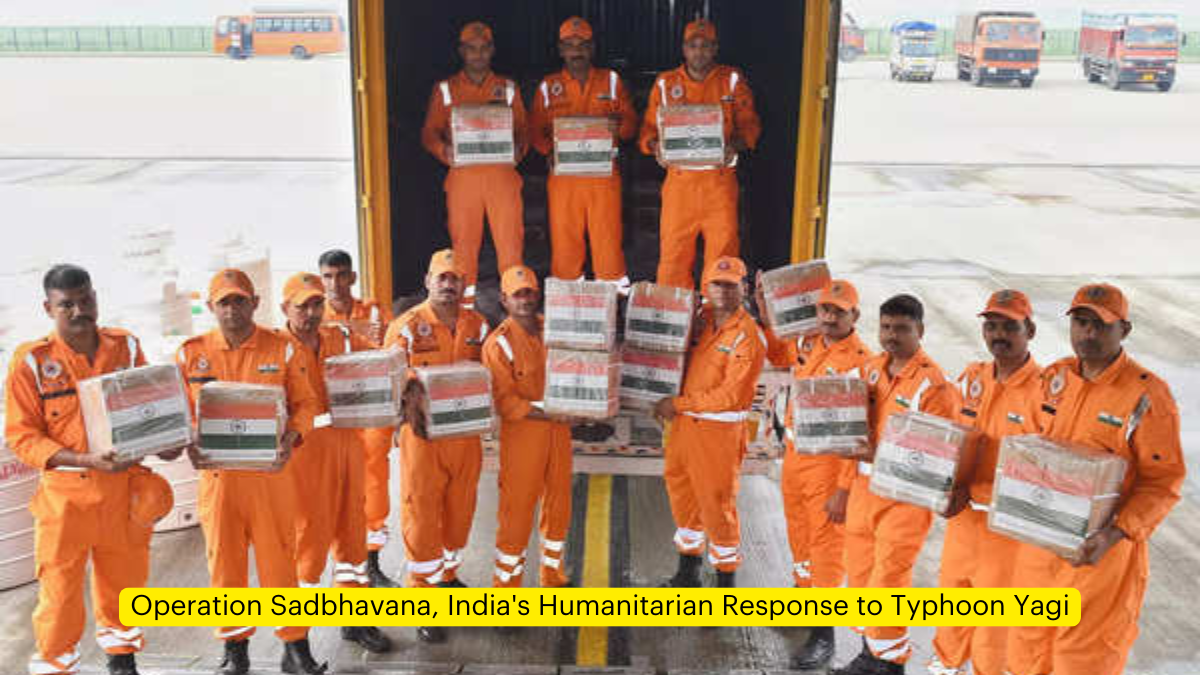Typhoon Yagi recently struck Southeast Asia, the government of India has launched Operation Sadbhavana, a humanitarian initiative aimed at providing crucial assistance to affected countries. This operation exemplifies India’s commitment to its Act East Policy and its role as a first responder in providing Humanitarian Assistance and Disaster Relief (HADR) to nations in need.
India’s Humanitarian Assistance
Aid to Vietnam
As part of Operation Sadbhavana, the Indian government has announced a substantial aid package for Vietnam:
Amount: USD 1 million in humanitarian assistance
Aid contents: 35 tons of relief supplies, including:
- Water purification items
- Water containers
- Blankets
- Kitchen utensils
- Solar lanterns
- Other essential items
This comprehensive aid package aims to address the immediate needs of those affected by the typhoon, focusing on providing clean water, shelter, and basic necessities.
Support for Lao People’s Democratic Republic
In addition to its assistance to Vietnam, India has also extended support to the Lao People’s Democratic Republic:
Amount: USD 100,000 in humanitarian assistance
Aid contents: 10 tons of relief supplies, including:
- Hygiene kits
- Blankets
- Mosquito nets and repellents
- Sleeping bags
- Generators
- Water purifiers
- Water purification tablets
- Disinfectants
- Other essential materials
This aid package is designed to help mitigate the impact of the typhoon on the Lao population, with a focus on health, sanitation, and basic survival needs.
Typhoon Yagi: An Overview
Origin and Intensity
Typhoon Yagi has earned the distinction of being the most powerful storm to originate in the South China Sea in the last three decades. Some key points about the typhoon include:
- Wind speed: Exceeding 142 miles per hour
- Origin: South China Sea
- Name: Given by the Japanese Meteorological Agency
Affected Areas
The typhoon’s destructive path encompassed several countries in Southeast Asia:
- Vietnam
- Thailand
- Myanmar
- Lao People’s Democratic Republic
- Southern China
Impact on Vietnam
Of all the affected countries, Vietnam has suffered the most severe consequences:
- Death toll: Over 350 confirmed casualties, with expectations of further increases
- Flooding: Extensive areas in northern Vietnam submerged
- Economic impact: Destruction of agricultural lands, factories, and infrastructure
- Ongoing threats: Widespread flooding and landslides
Understanding Cyclones
Etymology and History
The term “cyclone” has an interesting origin:
- Derived from: Greek word “cyclos”
- Coined by: Henry Piddington, a British Rapporteur in Kolkata during the colonial era
Definition and Characteristics
A cyclone is defined as a wind system that circulates around a center of low atmospheric pressure. Its direction of rotation depends on its location relative to the equator:
- Northern Hemisphere: Counterclockwise rotation
- Southern Hemisphere: Clockwise rotation
Types of Cyclones
Cyclones are categorized based on their geographical origin:
Tropical Cyclones:
- Form within the Tropics of Capricorn and Cancer
- Originate over warm ocean waters near the equator
Temperate Cyclones:
- Originate in temperate, high-altitude areas
Global Distribution
Cyclonic winds are a global phenomenon, found in most parts of the world with one notable exception:
- Absent in: The equatorial region




 Operation Hawkeye: US and Jordan Strike ...
Operation Hawkeye: US and Jordan Strike ...
 India and the Netherlands Set Up Joint T...
India and the Netherlands Set Up Joint T...
 Brazil Hands Over BRICS Presidency to In...
Brazil Hands Over BRICS Presidency to In...







